Sertac Karaman
SCREP: Scene Coordinate Regression and Evidential Learning-based Perception-Aware Trajectory Generation
Jul 10, 2025Abstract:Autonomous flight in GPS denied indoor spaces requires trajectories that keep visual localization error tightly bounded across varied missions. Whereas visual inertial odometry (VIO) accumulates drift over time, scene coordinate regression (SCR) yields drift-free, high accuracy absolute pose estimation. We present a perception-aware framework that couples an evidential learning-based SCR pose estimator with a receding horizon trajectory optimizer. The optimizer steers the onboard camera toward pixels whose uncertainty predicts reliable scene coordinates, while a fixed-lag smoother fuses the low rate SCR stream with high rate IMU data to close the perception control loop in real time. In simulation, our planner reduces translation (rotation) mean error by 54% / 15% (40% / 31%) relative to yaw fixed and forward-looking baselines, respectively. Moreover, hardware in the loop experiment validates the feasibility of our proposed framework.
Real-Time Sampling-based Online Planning for Drone Interception
Feb 20, 2025Abstract:This paper studies high-speed online planning in dynamic environments. The problem requires finding time-optimal trajectories that conform to system dynamics, meeting computational constraints for real-time adaptation, and accounting for uncertainty from environmental changes. To address these challenges, we propose a sampling-based online planning algorithm that leverages neural network inference to replace time-consuming nonlinear trajectory optimization, enabling rapid exploration of multiple trajectory options under uncertainty. The proposed method is applied to the drone interception problem, where a defense drone must intercept a target while avoiding collisions and handling imperfect target predictions. The algorithm efficiently generates trajectories toward multiple potential target drone positions in parallel. It then assesses trajectory reachability by comparing traversal times with the target drone's predicted arrival time, ultimately selecting the minimum-time reachable trajectory. Through extensive validation in both simulated and real-world environments, we demonstrate our method's capability for high-rate online planning and its adaptability to unpredictable movements in unstructured settings.
Generating Out-Of-Distribution Scenarios Using Language Models
Nov 25, 2024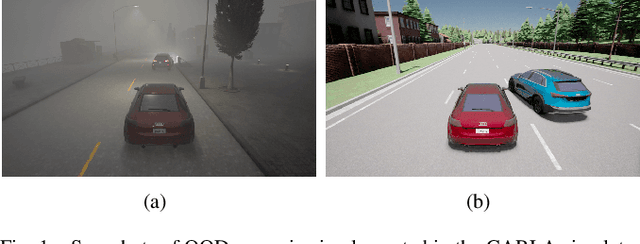
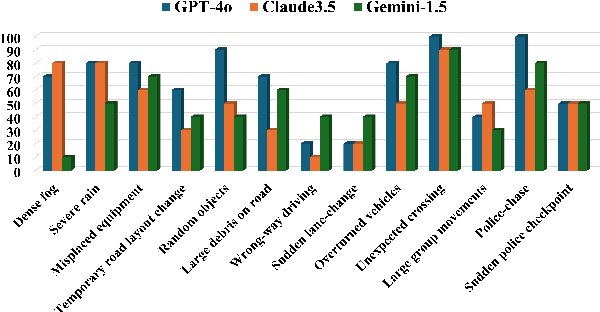
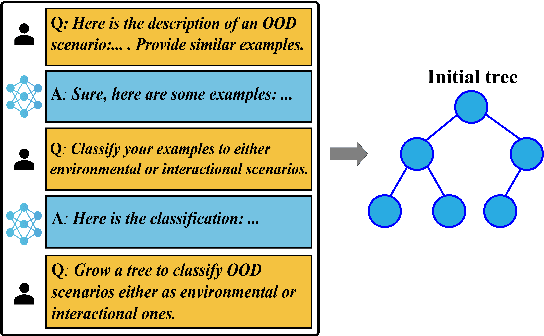

Abstract:The deployment of autonomous vehicles controlled by machine learning techniques requires extensive testing in diverse real-world environments, robust handling of edge cases and out-of-distribution scenarios, and comprehensive safety validation to ensure that these systems can navigate safely and effectively under unpredictable conditions. Addressing Out-Of-Distribution (OOD) driving scenarios is essential for enhancing safety, as OOD scenarios help validate the reliability of the models within the vehicle's autonomy stack. However, generating OOD scenarios is challenging due to their long-tailed distribution and rarity in urban driving dataset. Recently, Large Language Models (LLMs) have shown promise in autonomous driving, particularly for their zero-shot generalization and common-sense reasoning capabilities. In this paper, we leverage these LLM strengths to introduce a framework for generating diverse OOD driving scenarios. Our approach uses LLMs to construct a branching tree, where each branch represents a unique OOD scenario. These scenarios are then simulated in the CARLA simulator using an automated framework that aligns scene augmentation with the corresponding textual descriptions. We evaluate our framework through extensive simulations, and assess its performance via a diversity metric that measures the richness of the scenarios. Additionally, we introduce a new "OOD-ness" metric, which quantifies how much the generated scenarios deviate from typical urban driving conditions. Furthermore, we explore the capacity of modern Vision-Language Models (VLMs) to interpret and safely navigate through the simulated OOD scenarios. Our findings offer valuable insights into the reliability of language models in addressing OOD scenarios within the context of urban driving.
Learning autonomous driving from aerial imagery
Oct 18, 2024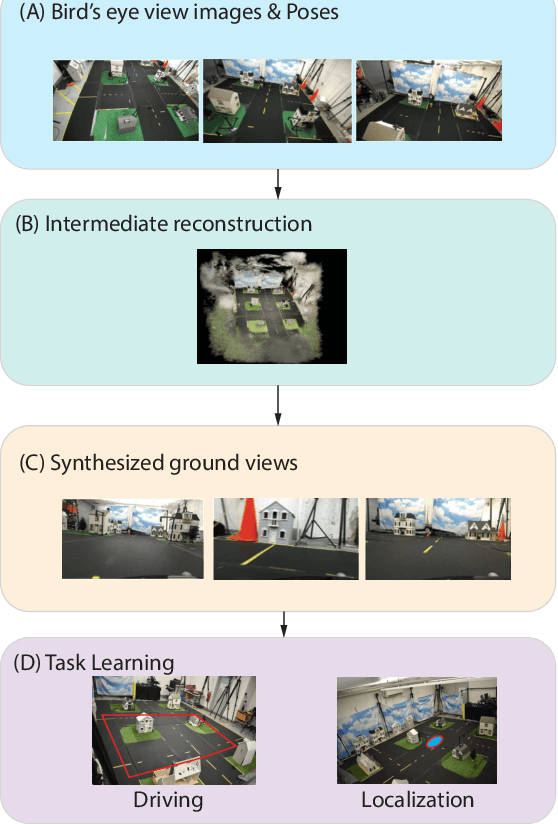
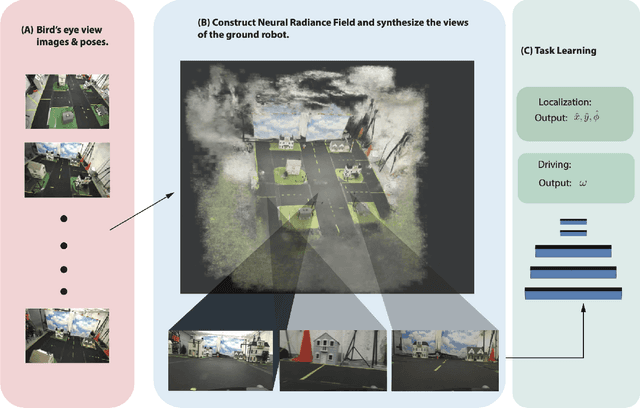
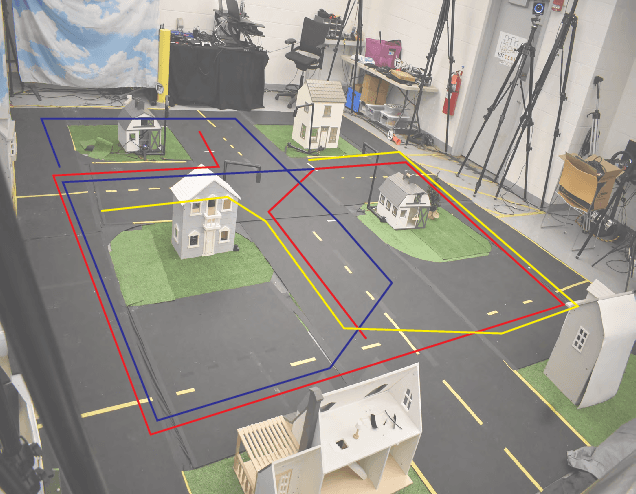
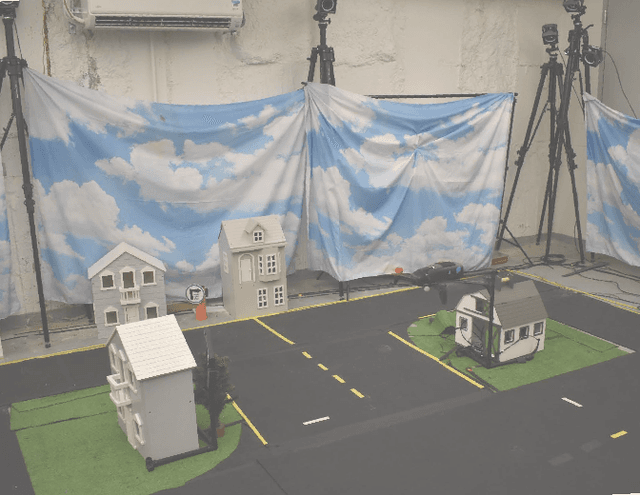
Abstract:In this work, we consider the problem of learning end to end perception to control for ground vehicles solely from aerial imagery. Photogrammetric simulators allow the synthesis of novel views through the transformation of pre-generated assets into novel views.However, they have a large setup cost, require careful collection of data and often human effort to create usable simulators. We use a Neural Radiance Field (NeRF) as an intermediate representation to synthesize novel views from the point of view of a ground vehicle. These novel viewpoints can then be used for several downstream autonomous navigation applications. In this work, we demonstrate the utility of novel view synthesis though the application of training a policy for end to end learning from images and depth data. In a traditional real to sim to real framework, the collected data would be transformed into a visual simulator which could then be used to generate novel views. In contrast, using a NeRF allows a compact representation and the ability to optimize over the parameters of the visual simulator as more data is gathered in the environment. We demonstrate the efficacy of our method in a custom built mini-city environment through the deployment of imitation policies on robotic cars. We additionally consider the task of place localization and demonstrate that our method is able to relocalize the car in the real world.
DecTrain: Deciding When to Train a DNN Online
Oct 03, 2024Abstract:Deep neural networks (DNNs) can deteriorate in accuracy when deployment data differs from training data. While performing online training at all timesteps can improve accuracy, it is computationally expensive. We propose DecTrain, a new algorithm that decides when to train a monocular depth DNN online using self-supervision with low overhead. To make the decision at each timestep, DecTrain compares the cost of training with the predicted accuracy gain. We evaluate DecTrain on out-of-distribution data, and find DecTrain maintains accuracy compared to online training at all timesteps, while training only 44% of the time on average. We also compare the recovery of a low inference cost DNN using DecTrain and a more generalizable high inference cost DNN on various sequences. DecTrain recovers the majority (97%) of the accuracy gain of online training at all timesteps while reducing computation compared to the high inference cost DNN which recovers only 66%. With an even smaller DNN, we achieve 89% recovery while reducing computation by 56%. DecTrain enables low-cost online training for a smaller DNN to have competitive accuracy with a larger, more generalizable DNN at a lower overall computational cost.
GEVO: Memory-Efficient Monocular Visual Odometry Using Gaussians
Sep 14, 2024Abstract:Constructing a high-fidelity representation of the 3D scene using a monocular camera can enable a wide range of applications on mobile devices, such as micro-robots, smartphones, and AR/VR headsets. On these devices, memory is often limited in capacity and its access often dominates the consumption of compute energy. Although Gaussian Splatting (GS) allows for high-fidelity reconstruction of 3D scenes, current GS-based SLAM is not memory efficient as a large number of past images is stored to retrain Gaussians for reducing catastrophic forgetting. These images often require two-orders-of-magnitude higher memory than the map itself and thus dominate the total memory usage. In this work, we present GEVO, a GS-based monocular SLAM framework that achieves comparable fidelity as prior methods by rendering (instead of storing) them from the existing map. Novel Gaussian initialization and optimization techniques are proposed to remove artifacts from the map and delay the degradation of the rendered images over time. Across a variety of environments, GEVO achieves comparable map fidelity while reducing the memory overhead to around 58 MBs, which is up to 94x lower than prior works.
Text-to-Drive: Diverse Driving Behavior Synthesis via Large Language Models
Jun 06, 2024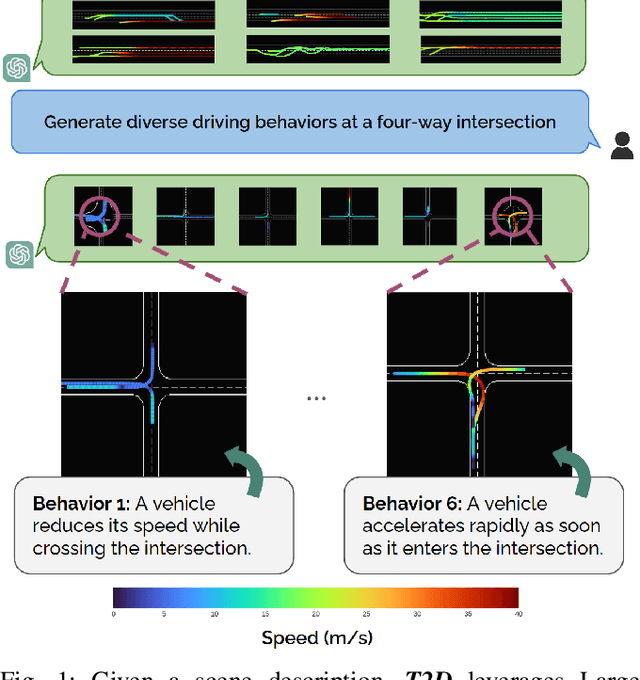
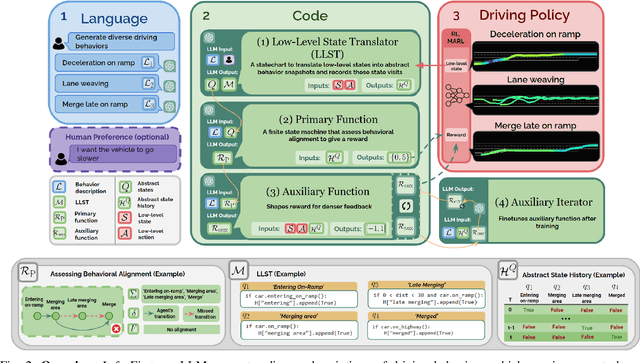
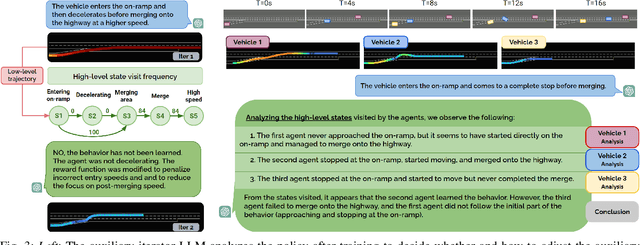
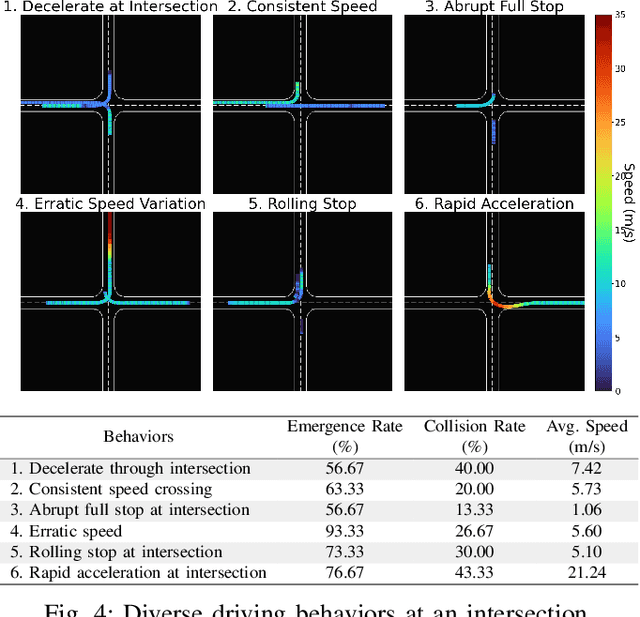
Abstract:Generating varied scenarios through simulation is crucial for training and evaluating safety-critical systems, such as autonomous vehicles. Yet, the task of modeling the trajectories of other vehicles to simulate diverse and meaningful close interactions remains prohibitively costly. Adopting language descriptions to generate driving behaviors emerges as a promising strategy, offering a scalable and intuitive method for human operators to simulate a wide range of driving interactions. However, the scarcity of large-scale annotated language-trajectory data makes this approach challenging. To address this gap, we propose Text-to-Drive (T2D) to synthesize diverse driving behaviors via Large Language Models (LLMs). We introduce a knowledge-driven approach that operates in two stages. In the first stage, we employ the embedded knowledge of LLMs to generate diverse language descriptions of driving behaviors for a scene. Then, we leverage LLM's reasoning capabilities to synthesize these behaviors in simulation. At its core, T2D employs an LLM to construct a state chart that maps low-level states to high-level abstractions. This strategy aids in downstream tasks such as summarizing low-level observations, assessing policy alignment with behavior description, and shaping the auxiliary reward, all without needing human supervision. With our knowledge-driven approach, we demonstrate that T2D generates more diverse trajectories compared to other baselines and offers a natural language interface that allows for interactive incorporation of human preference. Please check our website for more examples: https://text-to-drive.github.io/
Probing Multimodal LLMs as World Models for Driving
May 09, 2024



Abstract:We provide a sober look at the application of Multimodal Large Language Models (MLLMs) within the domain of autonomous driving and challenge/verify some common assumptions, focusing on their ability to reason and interpret dynamic driving scenarios through sequences of images/frames in a closed-loop control environment. Despite the significant advancements in MLLMs like GPT-4V, their performance in complex, dynamic driving environments remains largely untested and presents a wide area of exploration. We conduct a comprehensive experimental study to evaluate the capability of various MLLMs as world models for driving from the perspective of a fixed in-car camera. Our findings reveal that, while these models proficiently interpret individual images, they struggle significantly with synthesizing coherent narratives or logical sequences across frames depicting dynamic behavior. The experiments demonstrate considerable inaccuracies in predicting (i) basic vehicle dynamics (forward/backward, acceleration/deceleration, turning right or left), (ii) interactions with other road actors (e.g., identifying speeding cars or heavy traffic), (iii) trajectory planning, and (iv) open-set dynamic scene reasoning, suggesting biases in the models' training data. To enable this experimental study we introduce a specialized simulator, DriveSim, designed to generate diverse driving scenarios, providing a platform for evaluating MLLMs in the realms of driving. Additionally, we contribute the full open-source code and a new dataset, "Eval-LLM-Drive", for evaluating MLLMs in driving. Our results highlight a critical gap in the current capabilities of state-of-the-art MLLMs, underscoring the need for enhanced foundation models to improve their applicability in real-world dynamic environments.
NVINS: Robust Visual Inertial Navigation Fused with NeRF-augmented Camera Pose Regressor and Uncertainty Quantification
Apr 01, 2024Abstract:In recent years, Neural Radiance Fields (NeRF) have emerged as a powerful tool for 3D reconstruction and novel view synthesis. However, the computational cost of NeRF rendering and degradation in quality due to the presence of artifacts pose significant challenges for its application in real-time and robust robotic tasks, especially on embedded systems. This paper introduces a novel framework that integrates NeRF-derived localization information with Visual-Inertial Odometry(VIO) to provide a robust solution for robotic navigation in a real-time. By training an absolute pose regression network with augmented image data rendered from a NeRF and quantifying its uncertainty, our approach effectively counters positional drift and enhances system reliability. We also establish a mathematically sound foundation for combining visual inertial navigation with camera localization neural networks, considering uncertainty under a Bayesian framework. Experimental validation in the photorealistic simulation environment demonstrates significant improvements in accuracy compared to a conventional VIO approach.
Multi-Fidelity Reinforcement Learning for Time-Optimal Quadrotor Re-planning
Mar 13, 2024Abstract:High-speed online trajectory planning for UAVs poses a significant challenge due to the need for precise modeling of complex dynamics while also being constrained by computational limitations. This paper presents a multi-fidelity reinforcement learning method (MFRL) that aims to effectively create a realistic dynamics model and simultaneously train a planning policy that can be readily deployed in real-time applications. The proposed method involves the co-training of a planning policy and a reward estimator; the latter predicts the performance of the policy's output and is trained efficiently through multi-fidelity Bayesian optimization. This optimization approach models the correlation between different fidelity levels, thereby constructing a high-fidelity model based on a low-fidelity foundation, which enables the accurate development of the reward model with limited high-fidelity experiments. The framework is further extended to include real-world flight experiments in reinforcement learning training, allowing the reward model to precisely reflect real-world constraints and broadening the policy's applicability to real-world scenarios. We present rigorous evaluations by training and testing the planning policy in both simulated and real-world environments. The resulting trained policy not only generates faster and more reliable trajectories compared to the baseline snap minimization method, but it also achieves trajectory updates in 2 ms on average, while the baseline method takes several minutes.
 Add to Chrome
Add to Chrome Add to Firefox
Add to Firefox Add to Edge
Add to Edge